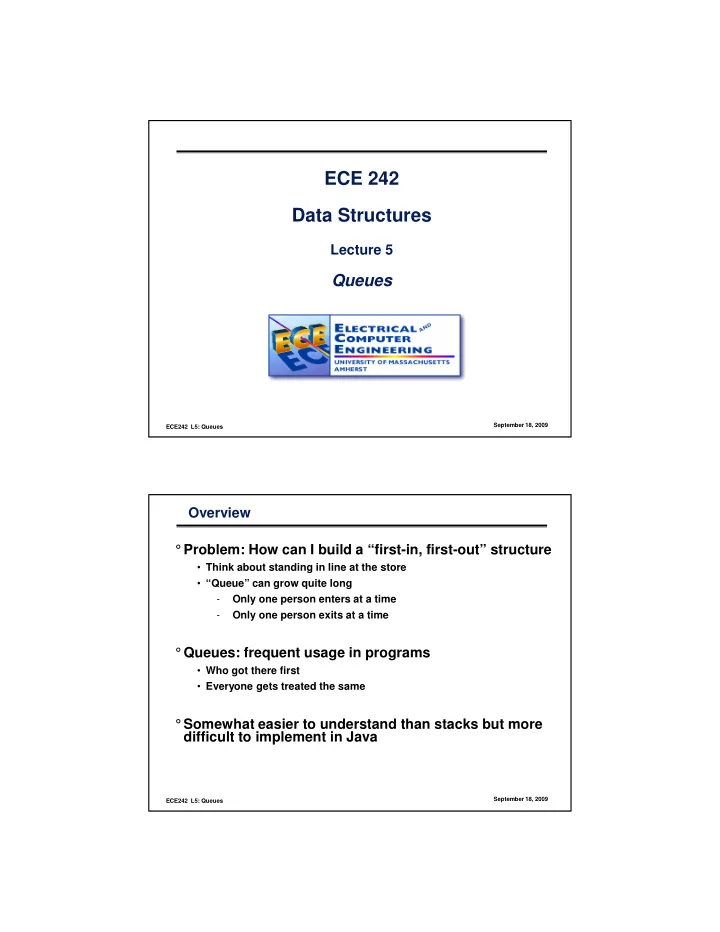

ECE 242 Data Structures Lecture 5 Queues September 18, 2009 ECE242 L5: Queues Overview ° Problem: How can I build a “first-in, first-out” structure • Think about standing in line at the store • “Queue” can grow quite long - Only one person enters at a time - Only one person exits at a time ° Queues: frequent usage in programs • Who got there first • Everyone gets treated the same ° Somewhat easier to understand than stacks but more difficult to implement in Java September 18, 2009 ECE242 L5: Queues
Queue ° Queue: First In First Out (FIFO) Output Input D C B A ° Toll Station • Car comes, pays, leaves ° Check-out in Big Y market • Customer comes, checks out and leaves ° More examples: Printer, Office Hours, … September 18, 2009 ECE242 L5: Queues What Is A Queue? ° Queue is an abstract data type ° Adding an entry at the tail ° Deleting an entry at the head Adding Deleting C B A front back September 18, 2009 ECE242 L5: Queues
Abstract Data Types ° Queue • Operating on both ends • Operations: EnQueue(in), DeQueue(out) ° Not possible to add/delete in middle of queue enqueue dequeue C B A back front September 18, 2009 ECE242 L5: Queues Applications of Queue ° Printing Job Management ° Packet Forwarding in Routers ° Message queue in Windows ° I/O buffer Note that we haven’t specified a size or an implementation September 18, 2009 ECE242 L5: Queues
Example: Printing Job Management ° Many users send their printing jobs to ECS public printer ° Printer will put them into a queue according to the arrival time and print the jobs one by one ° These printing documents are A.doc, B.doc, C.doc and D.doc ° Other applications • Packet Forwarding in Routers • Message queue in Windows • I/O buffer September 18, 2009 ECE242 L5: Queues Printing Queue ° A.doc B.doc C.doc arrive to printer. Now printing A.doc C B A C B A.doc is finished. Now printing B.doc D.doc comes D C B Now still printing B.doc D C B.doc is finished. Now printing C.doc D C.doc is finished. Now printing D.doc September 18, 2009 ECE242 L5: Queues
First-in First-out (FIFO) A, B, C come in The first one enqueued is the first C B one dequeued. (FIFO) A C When we enqueue entries in the queue and B A then dequeue them one by one, we will get the A, B, C come out items in the same order. items in the same order. C B A September 18, 2009 ECE242 L5: Queues Question ° Queue is an abstract data structure ° Item can be Integer, Double, String, Employee, Faculty … ° How to implement a general queue for all those types? September 18, 2009 ECE242 L5: Queues
Abstract Data Type ° Same as Stack, we use Object data type instead of int or double or String or other data type ° Use an array in queue, which stores all items come in. • Object Queue[ ]; ° Other implementations are possible September 18, 2009 ECE242 L5: Queues Array Implementation of Queue n-1 3 2 1 0 D C B A rear front Max_Size After A leaves, n-1 3 2 1 0 D C B rear front Max_Size September 18, 2009 ECE242 L5: Queues
Operations ° enqueue • add a new item at the rear ° dequeue • remove a item from the front ° isEmpty • check whether the queue is empty or not ° isFull • check whether the queue is full or not ° size • return the number of items in the queue ° peek • return the front item September 18, 2009 ECE242 L5: Queues Problem ° An array has limited size, once back is at the end of this array, and there is new item coming in, what can we do? n-1 3 2 1 0 Y X…… front back September 18, 2009 ECE242 L5: Queues
Two Solutions ° Shifting all items to front in the array when dequeue operation. ( Too Costly… ) n-1 3 2 1 0 n-1 3 2 1 0 A leaves …… C B A …… C B back=3 front=0 back=2 front=0 ° Wrapped around array ---- Circular Array September 18, 2009 ECE242 L5: Queues Circular Array ° Wrapped around array back=3 3 2 C 1 front=0 n-1 3 2 1 0 B …… C B A 0 A n-1 back=3 front=0 September 18, 2009 ECE242 L5: Queues
EnQueue & DeQueue In Circular Array ° EnQueue • DeQueue • back = (back + 1) MOD n – front = (front + 1) MOD n back=3 front=1 3 3 2 2 C C 1 1 B B 0 A 0 n-1 n-1 September 18, 2009 ECE242 L5: Queues Empty/Full In Circular Array ° When rear equals front, Queue is empty ° When (rear + 1) MOD n equals front, Queue is full ° Circular array with capacity n at most can hold n-1 items. September 18, 2009 ECE242 L5: Queues
Summary ° Queues are often implemented via interfaces • Hides low level implementations ° Queues can be tricky to implement • Usually implemented with arrays ° Queues useful for many applications • Allows uniform access ° Next time: More queues September 18, 2009 ECE242 L5: Queues
Recommend
More recommend